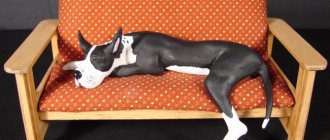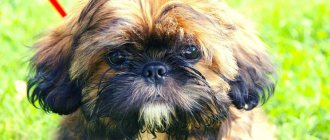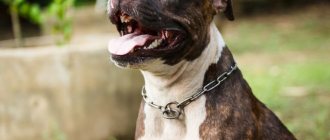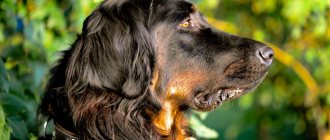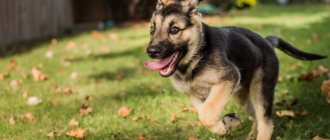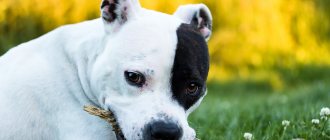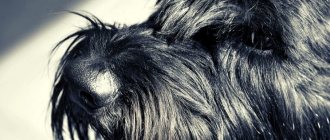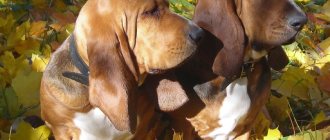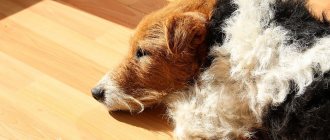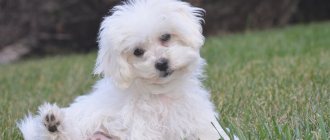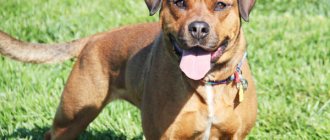It is believed that the Rottweiler is a very dangerous dog, capable of suddenly biting and even mauling a person. The opinion is fueled by numerous press reports about attacks by these animals on people. However, this is not a fighting dog. The standard clearly states the following characteristics: the breed is a service and working breed.
The dog is unusually loyal, friendly and calm. Let's figure out what turns pets into vicious killers.
A Brief History of the Rottweiler Breed
The breed is descended from mastiff-like dogs that lived in ancient Rome - this is the most popular version, but the exact history remains a mystery. Most likely, the ancestors were Tibetan mastiffs. In those days, animals were used for driving and grazing livestock.
Later they ended up in the German region of Rottweil, where they were involved in guarding and transporting convoys with meat.
At the beginning of the 20th century, the need arose to use dogs for police purposes. They passed tests that confirmed their fitness for duty. In 1921, the first breed club was created, whose members developed an official standard.
Interesting Facts
There are many interesting things associated with the Rottweiler breed. Here are just some facts:
- According to historical data, dogs resembling modern representatives of the breed took part in the Seven Years' War - one of the largest armed conflicts of the 18th century.
- In the old days, German butchers hung purses around the necks of their dogs. No one in their right mind would risk robbing a four-legged defender.
- Rottweilers are prohibited from being imported into some countries because they are considered potentially dangerous. The list includes Israel, Bermuda, Portugal, Ecuador.
Breed description, standards and appearance
The Rottweiler is a large dog, strong, but not very massive. Correctly built individuals demonstrate strength and power, concentrated in a fairly compact body.
Dimensions of an adult dog of this breed:
- boys' height is 61-68 cm, girls' height is 56-63 cm;
- the maximum weight of a Rottweiler is 50 kg and 42 kg, respectively.
This is interesting. The largest Rottweiler in the world weighs more than 95 kg. A girl named Bewdel lives in the UK. She became the star of the show Fat Pets.
Also, when assessing the exterior, other dimensions of an adult animal are taken into account - the elongation index, the depth and width of the chest, the width of the ribs.
Official description of the Rottweiler breed (ICF standard No. 147):
- The skull is wide, with a prominent forehead line.
- The length of the muzzle is proportional to the skull.
- The nose is wide and black.
- The lips fit tightly to the jaws.
- The jaws are powerful and strong, closed in a scissor bite.
- The eyes are dark brown, medium, almond-shaped.
- The ears of the representatives of the breed are hanging, triangular in shape, sitting high and wide.
- The neck is strong, with a slightly curved nape line.
- The chest is massive and deep. The back and loin are powerful and strong, the croup is wide and slightly rounded. The belly is not tucked in.
- The modern characteristics of the breed allow the tail to be left in its natural form. Previously it was subject to docking.
- The limbs are straight, set quite widely.
Color
Representatives of the breed have a two-layer coat with a thick undercoat. The only permitted color for a Rottweiler is black and tan. Red-brown markings are located in strictly defined places - on the face, throat, chest and paws, around the genitals.
Experts are lenient when it comes to excessively extensive markings - this is a defect, but not a disqualifying defect. But a completely black Rottweiler means that there are deviations in the genotype - blackened tan. Such a dog cannot participate in exhibitions, just like a chocolate Rottweiler.
Other deviations from the standard are the red and golden Rottweiler. These are not varieties, but mestizos with related breeds. In particular, with Dogues de Bordeaux and boxers.
On a note. Some people mistakenly believe that there is a Golden Rottweiler or Golden Rottweiler. The confusion is caused by its similarity with another breed - the golden retriever (golden retriever). These are completely different animals.
The white Rottweiler does not exist in nature. If there are white spots on the body, the animal is disqualified. Sometimes lightening of the color provokes a disease - vitiligo.
The puppy may also be born with long hair. Representatives of the breed with long or curly hair are immediately discarded.
Breed varieties
There are no recognized intrabreed varieties, but the standards of different countries have some differences:
- German are classic representatives of the breed. It was their characteristics that formed the basis of the ICF standard.
- English - English breeders focused on the character of the dogs: they achieved complete equanimity while maintaining working qualities.
- American - larger and more aggressive individuals were used for breeding. Animals are ready to tear apart any creature that invades their territory.
Breed characteristics vary slightly depending on the breeding line. Finnish dogs have elongated muzzles, a stocky build and a lightened color, Austrian dogs are slightly shorter than standard dogs, but perfectly built, Norwegian dogs are taller due to their long limbs.
Depending on height, the FCI standard divides the breed into 4 groups:
| Height (cm) | Characteristic | |
| Boy | Girl | |
| 61-62 | 56-57 | Little rottweiler |
| 63-64 | 58-59 | Average |
| 65-66 | 60-61 | Normal (preferred) |
| 67-68 | 62-63 | Large |
Due to breeder errors, birth injuries or genetic abnormalities, a mini species appeared. Such dogs are smaller than even the smallest standards. Usually they have a whole bunch of concomitant diseases, so the dwarf Rottweiler is not allowed to participate in exhibitions and breeding.
Health
Rottweilers are generally healthy animals. However, they are predisposed to certain diseases due to their organ structure and genetics.
Usually this:
- Hip dysplasia;
- Acute gastric dilatation and gastric volvulus;
- Obesity;
- Allergy;
- Hypothyroidism;
- Cancer diseases.
For this reason, it is recommended to buy puppies from large and well-known nurseries, and periodically undergo examinations by veterinarians.
Character and behavior
Despite its menacing appearance, the Rottweiler's character is characterized by friendliness, loyalty and obedience. At the same time, dogs of this breed are self-confident, fearless and balanced. However, kindness extends only to the owner and his family members - the animal perceives strangers as a potential threat.
On a note. Features of the Rottweiler breed are sensitivity to the environment and the mood of the owner. In families where there is often scandal, dogs grow up nervous and angry.
Rottweiler and children
A well-mannered dog and a child will become good friends. The pet will tolerate small pranks, but it is forbidden to show obvious disrespect - pulling ears and tail, poking in the eyes. The dog may bite the baby in an attempt to show that such behavior is unacceptable. Therefore, it is dangerous to leave a dog unattended in a children's room.
Watchdog and security qualities
This breed of dog has excellent working characteristics - the animals make decisions with lightning speed if the owner or his property is in danger. But to develop the innate potential, regular classes and professional training are necessary.
Preventive methods
The sooner the prevention of dominant behavior in a Rottweiler begins, the fewer problems there will be with the manifestation of hierarchical aggression. You must become a leader for him from the first day he appears in the house.
The place where the puppy will sleep needs to be decided once and for all. You need to stop every attempt to climb into a chair, onto a bed and other places where you and your family members rest and sleep. To show your dog your leadership, you can from time to time drive it away from a forbidden place and settle there instead.
If the Rottweiler decides to block your path and lies down in the middle of the room, you should not walk around or step over it. The correct action is to clear the way for yourself by pushing the dog away with your foot. If he growled, it means there are problems with aggression. Continue in this manner until the dog no longer interferes with your movements.
Never allow your Rottweiler to leave your room, house, apartment, or entrance before you. A dog that respects its owner should always go second.
During feeding, the Rottweiler may be aggressive towards your presence, preventing you from removing the bowl in a timely manner. Most likely, you allowed him to eat earlier than you, or fed him from your table. In any case, begin to develop endurance in the animal - make it wait until you eat yourself. While the Rottweiler is eating, keep the bowl for the prescribed fifteen minutes and remove it, despite the indignation. You are the leader - you decide when and how much he eats.
Never be overly affectionate. This will not make the dog happier, but it will expand the boundaries of what is permitted. There should only be strict discipline and a timely “good” or “well done.”
Also, the dog should not show aggression if you take away something that belongs to it. Only the leader can decide when to start the game and when to end it. Therefore, you should not allow your growing puppy to become the owner of toys. If the Rottweiler starts to growl, scold him while shaking him by the scruff of the neck.
The behavior of a dog that is capable of biting is corrected with the help of a leash - pull until it lets go of the toy. If this does not happen, wait until the dog abandons it on its own. Then throw the toy away - your Rottweiler should never play with it again.
If you start a game of tug of war with your puppy, never let go of the rope if he starts to get angry. Otherwise, you will let the Rottweiler know that if I growl, I will get whatever I want.
All household members should do the same. This way, the Rottweiler will learn while still a puppy that he comes last in the family hierarchy and will not show aggression towards your family.
At certain times, the dog must undergo special courses, with the help of which he develops the skills of obedience, respect and protection of the owner. You can find out more in the article “Features of training Rottweilers.”
How to choose the right Rottweiler puppy?
A Rottweiler puppy is ready to go to a new home at 8-10 weeks. Babies should be purchased from reliable nurseries registered with the RKF/IKF. Sick animals or puppies with temperament defects are often sold on the Internet.
A responsible breeder will provide detailed characteristics of the litter and parents. An adult Rottweiler should be calm, balanced and friendly.
Important. To make sure that your Rottweiler puppy does not suffer from dysplasia, you need to study x-rays of the parents' limbs.
The breeder's willingness to answer all questions speaks in favor of the breeder. He will definitely ask where the Rottweiler puppy will live and whether the future owner has experience in raising large dogs.
Equally important are the conditions of detention - the Rottweiler puppy should be in a spacious, clean and dry enclosure. healthy babies play with pleasure with their relatives, are not afraid and do not hide from strangers.
You should pay attention to the character - even if the Rottweiler puppy becomes a bodyguard or security guard, he should not be overly angry. Such dogs are culled.
When the choice of a puppy is made, the parties sign a purchase and sale agreement, guaranteeing the breed and health of the dog. Along with the document, the breeder gives the owner a veterinary passport and birth certificate.
The cost of puppies varies depending on the class: pet-class dogs can be bought for 12,000-18,000 rubles, breed class for 18,000-50,000 rubles, and show class, as always the most expensive, – 60,000-100 000 rub.
On a note. Pedigree puppies can be bought in Moscow at the Olburd kennels https://www.olburd.ru and the Tsarskaya Stay kennels https://www.rottweiler-rkf.com.
Boy or girl?
The characteristics of representatives of both sexes have their own characteristics. Male dogs look solid and impressive, but only a physically and mentally strong man can cope with him. A Rottweiler girl is suitable for a person with little experience - she is softer and calmer. However, females do not tolerate members of the canine community of the same sex.
Nutrition
Dog handlers advise alternating dry food mixtures and natural products when feeding an animal.
The following ingredients should be included in the dog's menu:
- Boiled meat (turkey, chicken, veal).
- Porridge (rice, buckwheat, millet).
- Low-fat cottage cheese, kefir or fermented baked milk.
- Stewed vegetables (carrots, zucchini, eggplant).
Give your dog pieces of fruit and cheese (in small quantities) as treats. Water for the animal must be boiled and cooled to room temperature before serving. Dry food should be given to the dog after preliminary soaking.
The food mixture must contain sufficient quantities of the following components:
- Vitamin D
- Calcium.
- Phosphorus.
- Omega-3 fatty acids and microelements.
- Prebiotic fibers that normalize the functioning of the digestive system.
Rottweilers have a tendency to overeat, so the owner must feed the animal strictly on a schedule. Puppies should be given food 4-5 times a day. An adult dog needs two meals a day.
Care and maintenance
Caring for a Rottweiler is not at all difficult - the characteristics of the breed include unpretentiousness. It is enough to carry out hygiene procedures on time and walk your pet regularly.
The idea of keeping a Rottweiler outside in winter in a private home seems absurd to some people. At first glance, it seems that short wool does not retain heat well. However, many owners and breeders advocate keeping them outside.
Representatives of the breed do not tolerate heat very well, but the Rottweiler can live outside in winter if there is an insulated kennel. With the onset of cold weather, the dog acquires a thick undercoat, which perfectly protects against frost.
Street keeping is suitable for residents of the middle zone - in this region animals easily endure winter. But at extremely low temperatures, the booth or enclosure must be heated.
Important. In winter, the Rottweiler needs more food because it uses a lot of energy.
Caring for your Rottweiler includes regular walks. According to the law of the Russian Federation, a dog must always be on a leash and muzzle on the street. All potentially dangerous breeds need appropriate ammunition.
It is better to purchase a muzzle for a Rottweiler from metal wire with a chrome coating and a leather insert in the bridge of the nose. This design is quite strong, durable and comfortable.
The right diet
Representatives of the breed can eat both high-quality ready-made food and homemade food. With natural feeding, the basis of nutrition for an adult dog is lean meat and offal. Additionally, pets are given:
- sea fish;
- porridges – rice, oatmeal, buckwheat;
- fermented milk products;
- eggs;
- fresh or boiled vegetables.
A Rottweiler living in an apartment needs vitamins more than a street dog, since it does not receive enough fresh air and sunlight. Suitable supplements should be selected in consultation with your veterinarian.
For information on how to balance your dog’s diet, read the article “What to feed your Rottweiler.”
Walking and physical activity
Rottweiler dogs should walk twice a day for at least 20 minutes, and preferably 1-1.5 hours - they need physical activity. To keep your pet in good shape, you need to play outdoor games with it.
Training and education
The dog of this breed is very intelligent, however, given its characteristics, it must be led by a person with a strong character and experience in raising service dogs. During adolescence, Rottweiler puppies will definitely try to take a leadership position. Unwanted behavior should be stopped immediately, but without violence.
Puppies can be taught commands as early as two months. This is not yet professional training, but it is already possible to develop basic skills in a playful way. At approximately 8 months, the puppy is sent to a puppy dog, since an uncontrollable dog is dangerous both for others and for the owner himself.
Read more about the secrets of training Rottweilers here.
In the wrong hands, a pet can turn into a formidable weapon. Careless owners either do not raise the puppy at all, or teach the command “Fast!” without passing the OKD. By deliberately developing anger, people lose control over the animal, which is fraught with unexpected attacks and unmotivated aggression.
These are the dogs that are called killers. However, it is necessary to understand that the animal itself is not at all to blame for this. Mental problems develop as a result of prolonged stress - moral pressure, violence and beatings. Any, even the most peaceful puppy can be “broken” and turned into a source of danger.
Expert opinion
Leonid Rodin
Experienced dog breeder
Ask a Question
The Rottweiler breed divided the dog lovers community into two almost equal halves in the 1990s. Some were delighted with the fiercely protective work ethic combined with good nature and devotion to family. And others saw these dogs as cruel, uncontrollable killers, attacking everything that moved. Both the first and second were right. As soon as the fashion for Rottweilers passed and unprofessional breeding faded away, breeders very quickly coped with the negative transformation of character. Nowadays, Rottweilers are rarely the subject of horror stories about dog cruelty. They are indispensable in rescue operations and diligently guard property. In 2015, a Rottweiler named Wind received the prestigious Human Fund award as the best therapy dog. An unbalanced, angry dog could never achieve such success.
Hygiene
Short fur is combed a couple of times a week; during shedding, the undercoat is removed with a slicker brush. Bathing is required 2-3 times a year. Once a week they wipe their eyes, clean their ears and teeth. Nails are trimmed as they grow, but active dogs usually grind them down on their own.
Vaccinations and susceptibility to disease
The puppy's first vaccination is given at 8-10 weeks. For this purpose, complex vaccines containing strains are used:
- plague;
- viral hepatitis;
- leptospirosis;
- parvovirus enteritis;
- parainfluenza.
2 weeks before vaccination, puppies are given anti-worm medications and treated against blood-sucking parasites. Vaccination may cause lethargy, drowsiness, and a slight increase in temperature. If symptoms do not go away within 2-3 days, the puppy should go to the vet.
Important. Only a completely healthy dog is ready to receive the vaccine. If you feel unwell, the procedure should be postponed until a later time.
After 3-4 weeks, the puppies are vaccinated again with the addition of a rabies vaccine. Thereafter, vaccinations are given annually. The veterinarian has the right to adjust the schedule, taking into account the prevalence of certain diseases in a particular area.
After vaccination, the Rottweiler puppy is in quarantine for 2 weeks. He is protected from:
- cold;
- drafts;
- excessive loads;
- contact with other animals.
Dogs that have not been vaccinated are not allowed to show or breed.
Important. All information about vaccinations is recorded in the veterinary passport. Every puppy must have a document.
The breed is prone to joint diseases and often suffers from eye problems - cataracts and retinal atrophy. Other typical pathologies:
- Addison's disease;
- decreased blood clotting;
- aortic valve stenosis;
- volvulus.
If a dog is born from healthy parents, problems are extremely rare.
Lifespan
The breed cannot be described as a long-liver - on average, dogs live 8–10 years. However, with good heredity and proper care, the period increases by 3–5 years.
Aggressive dog - correcting the situation
Rottweilers are certainly not killers, as many people think of them. But if you have an aggressive dog, in the future it can become dangerous both for you and your family, and for random passers-by.
Before you begin to correct the situation, evaluate your strength. Perhaps your dog is more energetic and stronger than you. Then it will not be easy for you to convince him of your superiority. Never enter into an open conflict with a Rottweiler without complete confidence in your victory. By retreating, for example, during a fight, you will once again convince the dog that it is he who occupies a leadership position.
Decide in what cases you can control the situation. You can put pressure on your Rottweiler, forcing him to change his behavior pattern, using:
- rewards for correct behavior in the form of treats, free walks, friendly pats;
- punishment for disobedience by deprivation of favorite things;
- physical impact;
- castration.
If your Rottweiler continues to exhibit hierarchical aggression despite your best efforts, you will have to retrain the dog to someone who can handle it. In advanced cases, when an angry Rottweiler got out of control, began to ignore any commands and began to rush at everyone with a clear desire to bite, he is euthanized.
Hierarchical aggression is not the only type of aggression that Rottweilers are prone to. Instincts, a sense of ownership and much more can cause anger in a dog.
Pros and cons of the breed
The advantages of the breed are balance, loyalty, developed intelligence. Another plus is that the Rottweiler can be kept outside. Just not on a chain, otherwise your pet will develop mental disorders.
In order not to be disappointed in the breed, you need to take into account the disadvantages. The character of a boy is more complex - males are dominant and willful, so there will be a special approach to training them. They obey only one person, who is considered the leader.
The main pros and cons of the breed are presented in the table.
| pros | Minuses |
| Sharp mind | Dominance |
| Easy care | Difficulties in training |
| Balanced character | Dangerous if mishandled |
| Devotion | Tendency to obesity |
| Excellent security and guard qualities | |
| Low temperature resistance |
The breed is distinguished by its spectacular appearance, loyalty, endurance and excellent guard characteristics. But it is suitable only for an experienced dog breeder who can subdue a wayward dog and raise him correctly.
Feeding
The Rottweiler requires high-quality food. The food must be appropriate for its age.
They tend to be overweight, so keep an eye on your dog's calorie intake and weight level.
Treats can be good for training, but too many of them will quickly lead to obesity. He must always have access to clean and fresh drinking water.
If you have any suspicions about your pet's weight or diet, always contact your veterinarian.
Rottweiler at an exhibition
